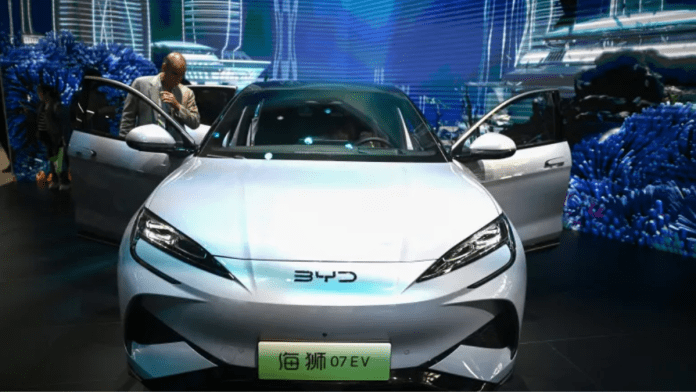🕒 Last updated on July 3, 2025
BYD Slows Down Production
BYD, China’s biggest electric vehicle (EV) company, is starting to face real trouble. After years of rapid growth, the company has quietly reduced the number of cars it is producing. Sources say that at least four of its factories have cut night shifts and lowered output by around one-third.
These changes are not small. In comparison to the 4.27 million cars it sold last year, BYD had ambitious goals to sell 5.5 million this year, a 30% increase. Based on sales volume, that figure placed it as the sixth-largest automaker globally. But now, things aren’t going as expected.
The production cuts have a straightforward explanation: sales are falling short of expectations. Automobiles are not leaving dealership lots quickly enough. Some claim that BYD is attempting to cut costs as well. Others believe it’s reacting to a slowdown in demand for its vehicles.
This slowdown is a major shift. BYD was once expanding at lightning speed. It was opening new lines, building new factories, and hiring new workers. Now, the same company is pressing the brakes and cancelling plans to build new production lines.
Inventory Keeps Building Up
BYD’s huge growth created another problem: too many unsold cars. When a company produces more cars than it can sell, those cars sit in lots. This is exactly what’s happening at BYD. Dealers now have more inventory than ever before.
In China, the typical BYD dealer had 3.2 months’ worth of unsold vehicles in stock. Compared to the industry average of 1.38 months, that is more than twice as long. This high inventory puts a lot of pressure on dealers. Cars lose value if they sit too long, and dealers still have to pay to store and maintain them.
Because of this, some dealers are now struggling to survive. Twenty locations nationwide had to be closed by one major BYD dealer. Those stores simply couldn’t sell enough cars to stay open. This is a serious warning sign.
In fact, the problem has grown so big that the China Auto Dealers Chamber of Commerce has stepped in. It asked car companies like BYD to stop sending so many cars to dealers. It wants them to slow production and better match their output to real sales numbers. This kind of request is rare and shows just how serious the issue is.
Growth Is Slowing
Just a few months ago, BYD was seen as unstoppable. It was growing faster than nearly every other car company in the world. But now, its growth is starting to fade.
In April, BYD’s output grew only 13% compared to the year before. In May, that number dropped even further—to just 0.2%. These are the lowest growth rates BYD has seen since February 2024.
Tesla under fire in France for misleading self-driving claims, faces €50,000 daily fines
The company’s average production in April and May was 29% less than in the fourth quarter of 2024, which is even more concerning. This means that, even though the company is still growing a little, it is doing so at a much slower pace—and producing far fewer cars than it did just a few months ago.
This is not what many expected from BYD. The company had built a reputation for beating expectations, scaling up fast, and challenging global giants. But now, its momentum is clearly slowing down.
Profits Stay Strong, But Pressure Grows
Despite all these problems, BYD is still making big money. In March 2025, it announced that its total revenue for 2024 reached 777 billion yuan. That’s about $108.3 billion in U.S. dollars. This even beat Tesla’s earnings of $97.7 billion for the same year.
Much of this success came from BYD’s hybrid cars, which mix electric and gas power. These cars are very popular in China and helped BYD stay profitable. The company has also led the way in launching affordable EVs, starting a price war that forced many rivals to lower their prices.
However, even profits can’t hide the growing cracks. The price war has helped boost sales but has also hurt profit margins and increased the number of unsold vehicles. Dealers are stuck with extra stock, and factories are now slowing down to keep up with the new reality.
BYD may still be on top for now, but the recent signs show that even the biggest players can face setbacks. The company’s fast climb has hit a few bumps, and now it’s trying to manage a new set of challenges—less growth, too much inventory, and fewer cars leaving the lot.
With slowing demand, rising stockpiles, and production cuts, the road ahead for BYD looks more difficult than it did just a year ago. The electric vehicle leader is now dealing with growing pressure from all sides—even while still posting record-breaking profits.

